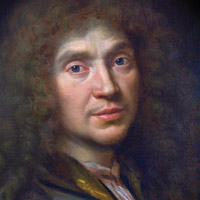
Molière was born Jean-Baptiste Poquelin in 1622, the son of a prosperous upholstery tradesmen. Educated by Parisian Jesuits, the young Jean-Baptiste had a promising inheritance awaiting him in his father’s trade; instead, however, he turned to acting, adopted the stage name of Molière, and aimed to become a great tragic actor. His first theatrical enterprise in Paris did not go well, and Molière spent the next thirteen years touring the provinces of France. During this time he began writing short comic farces, inspired by fashionable French verse comedy as well as the improvisational Italian commedia dell’arte. These comic trifles were the building blocks of The Misanthrope, Tartuffe, and the five-act verse comedies that would later prove to be some of the most enduring works of French drama.
Molière came of age as France was emerging into its Grand Siècle (“Great Century”). King Louis XIII’s chief minister, Cardinal Richelieu, maneuvered to weaken the power of the nobility and consolidate the king’s absolute authority, justified by a divine right to rule. This power play had a cultural strategy as well as a political and religious one; institutions like the Académie Française and, later, the Académie de Musique, put the monarchy at the center of France’s arts and letters. Every arena of French society fell within the orbit of the king and reflected his power; when Louis XIV took the throne in 1654, he promoted himself as the “Sun King,” demonstrating that, like the light of the sun, his power touched every corner of the realm.
A key symbol of this power under Louis XIV was Versailles, an opulent palace outside of Paris that served as a political instrument designed to hold visiting noblemen under the king’s watch. Instead of stirring up trouble far from the king’s influence, members of the court instead competed with one another for royal favor. They were rewarded with the privilege of taking part in royal ceremonies devised by Louis XIV, including the king’s coucher, an elaborate ritual in which an inner circle of favored noblemen helped the king prepare for bed. This careful attention to style and comportment made Louis the paragon of his age; throughout Paris, affluent members of society invested themselves in the fine arts of conversation and politesse. The refinement of the honnête homme—an aristocrat of exceptional taste and manners—was exhibited and exalted at the famous Parisian salons, a fashionable new sphere of public life where inspiring hostesses curated a vibrant collection of intellectuals and socialites.
It was this extraordinary cultural moment that greeted Molière’s company upon their return to Paris in 1658. Over the next fourteen years, and under the patronage of the Sun King, the man who began his career with aspirations for tragedy finally achieved success and notoriety for his comedy. Molière’s greatest plays, all of which he wrote after the age of thirty-five, were biting satires of contemporary society: Les Précieuses ridicules (“The Pretentious Young Ladies”), L’École des Femmes (“The School for Wives”), Les Femmes Savants (“The Learned Ladies”), Le Misanthrope, and Tartuffe. In all of his plays, Molière took the starring comic role; among his favorite characters to portray were jealous lovers or husbands, monomaniacal members of the bourgeoisie whose character flaws were exaggerated to the point of extreme comedy.
The Misanthrope (1666), a portrait of a man who holds the world in contempt for its social duplicity, is both exemplary of Molière’s comedic style but also a noteworthy exception: darker than his other comedies, it drew material from a serious but failed play Molière had once written called Don Garcie de Navarre. The Misanthrope’s playful dance between comedy and tragedy, embodied in the ridiculous yet noble character of Alceste and his fated romance with Celimène, deepens the emotional stakes of Molière’s piercing wit.
An early version of Tartuffe, Molière’s satire about a religious charlatan who insinuates himself into a bourgeois family, was performed for the king at Versailles in 1664. Though Louis XIV reportedly enjoyed the play, powerful religious factions in the court took offence to Molière’s portrait of a false religious figure, and Tartuffe was officially banned from public performance. While Molière made one entreaty to the king after another, Tartuffe provided forbidden entertainment to private audiences who asked for the play to be read or performed in their homes. Tartuffe achieved major success when it was finally allowed to have its public premiere in 1667, but not before Molière had been publically denounced by church officials, including by a parish priest who called him a “demon dressed in human flesh.”
Molière suffered from tuberculosis for most of his adult life, and at the age of 51, his pace had diminished due to ill health. On February 17, 1672 he was performing his play The Imaginary Invalid when he became ill on stage; he managed to finish the performance, but died shortly thereafter. At the time, actors were not technically allowed by the church to be buried in sacred ground, but Molière’s wife Armande appealed to the king, and he was buried under cover of night in an unmarked grave. Molière’s troupe survived to see itself incorporated into the Comedie Française, the state theater of France that still performs his works in repertory today and is commonly known as the “House of Molière.” As for the plays themselves, they joined the pantheon of world literature as some of the greatest comedies every written, surpassing in stature even the greatest tragedies of Molière’s time.